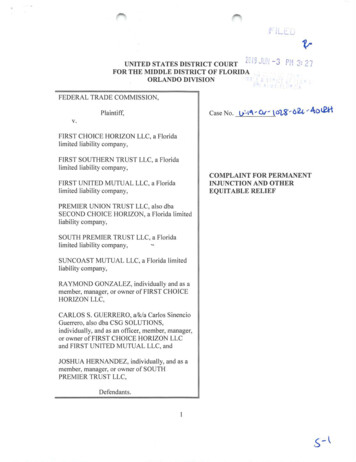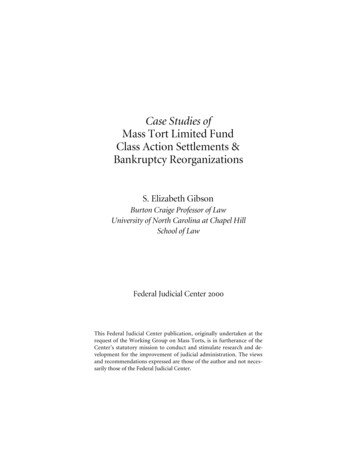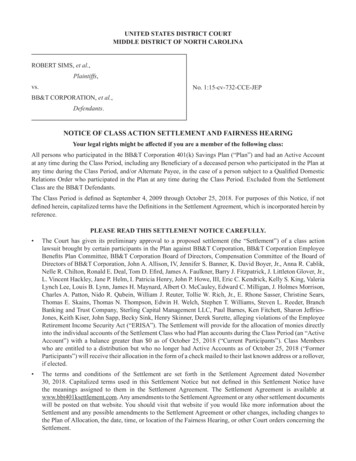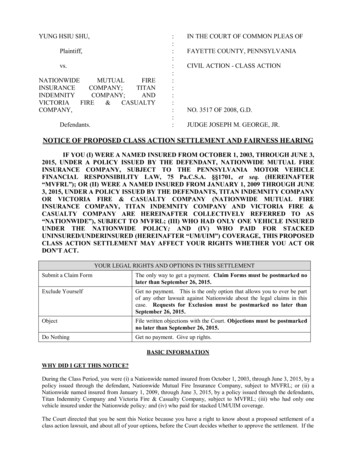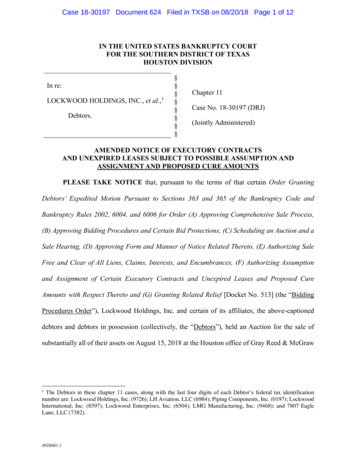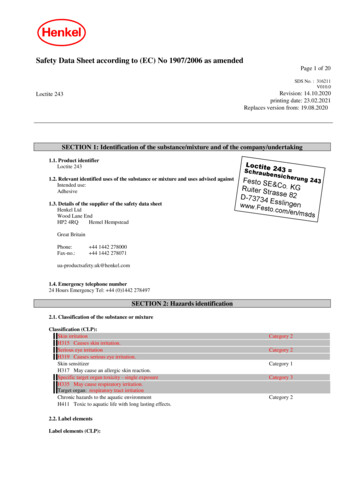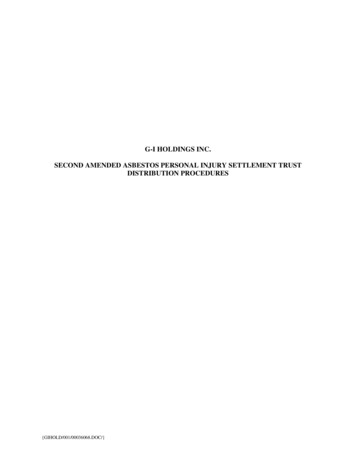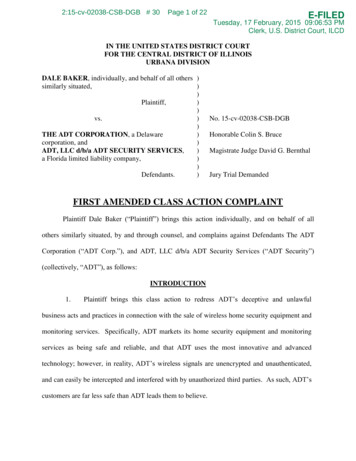
Transcription
2:15-cv-02038-CSB-DGB # 30Page 1 of 22E-FILEDTuesday, 17 February, 2015 09:06:53 PMClerk, U.S. District Court, ILCDIN THE UNITED STATES DISTRICT COURTFOR THE CENTRAL DISTRICT OF ILLINOISURBANA DIVISIONDALE BAKER, individually, and behalf of all others )similarly situated,))Plaintiff,))vs.))THE ADT CORPORATION, a Delaware)corporation, and)ADT, LLC d/b/a ADT SECURITY SERVICES,)a Florida limited liability company,))Defendants.)No. 15-cv-02038-CSB-DGBHonorable Colin S. BruceMagistrate Judge David G. BernthalJury Trial DemandedFIRST AMENDED CLASS ACTION COMPLAINTPlaintiff Dale Baker (“Plaintiff”) brings this action individually, and on behalf of allothers similarly situated, by and through counsel, and complains against Defendants The ADTCorporation (“ADT Corp.”), and ADT, LLC d/b/a ADT Security Services (“ADT Security”)(collectively, “ADT”), as follows:INTRODUCTION1.Plaintiff brings this class action to redress ADT’s deceptive and unlawfulbusiness acts and practices in connection with the sale of wireless home security equipment andmonitoring services. Specifically, ADT markets its home security equipment and monitoringservices as being safe and reliable, and that ADT uses the most innovative and advancedtechnology; however, in reality, ADT’s wireless signals are unencrypted and unauthenticated,and can easily be intercepted and interfered with by unauthorized third parties. As such, ADT’scustomers are far less safe than ADT leads them to believe.
2:15-cv-02038-CSB-DGB # 302.Page 2 of 22Through a variety of brands, including ADT, ADT Pulse, and CompanionServices, ADT provides electronic security, interactive home and business automation, andrelated monitoring services to approximately 6.5 million residential and small businesscustomers in the United States and Canada.3.The majority of ADT’s annual revenue (typically 90%) is driven by theequipment and services ADT provides, which are governed by multi-year contracts thatgenerate recurring revenue.4.ADT’s service offerings include the installation and monitoring of residentialand small business security and premises automation systems that react to movement, smoke,carbon monoxide, flooding, temperature and other environmental conditions and hazards, andaddress personal emergencies, such as injuries, medical emergencies or incapacitation.5.In its marketing materials, including on its website, ADT represents, inter alia,that it “has one of the most trusted and well-known brands in the security industry today.”Additionally, ADT’s marketing materials are intentionally designed to give potential customersthe overall net impression that its home security equipment and services are secure and reliable.6.However, ADT’s marketing materials and statements are misleading. ADT’shome security system wireless signals are unencrypted, unauthenticated, and otherwiseinsufficiently protected from intrusion and interference by unauthorized third parties. Indeed, itis easy for third parties to hack into ADT’s home security wireless signals and interfere withtheir transmission. For example, third parties can disable or suppress the home security system,or cause the system to activate an alarm when there is actually no security breach.2
2:15-cv-02038-CSB-DGB # 307.Page 3 of 22At all relevant times, ADT knew that its home security wireless signals wereunencrypted and therefore less safe and reliable than advertised, and that ADT does not use themost innovative and advanced technology.8.Yet, despite the ease with which ADT’s systems can be breached, ADT does notnotify customers about the fact that its wireless systems are unencrypted and insufficientlysecure to prevent third parties from interfering with them. To the contrary, all of ADT’smarketing materials promote the safety, security, and peace of mind that ADT’s systems willprovide to its customers.9.ADT’s misleading marketing statements and omissions are particularly egregiousin light of the fact that they provide a false sense of security to those individuals and businessesthat are most vulnerable: individuals and businesses who are seeking the comfort of an extralevel of security that a home security system provides.10.ADT’s knowing misrepresentations and omissions regarding the quality of itshome security systems and the safety that the systems provide, and ADT’s failure to encrypt orotherwise secure its wireless signals, violates the Florida Deceptive and Unfair Trade PracticesAct (“FDUTPA”), Fla. Stat. §501.201, et seq., Illinois Consumer Fraud and Deceptive BusinessPractices Act (“ICFA”), 815 ILCS 505/1, et seq., subject ADT to strict liability in tort, andconstitutes unjust enrichment.11.Plaintiff, on behalf of himself and the putative Class, seeks declaratory andinjunctive relief pursuant to Federal Rule of Civil Procedure 23(a) and (b)(2) requiring ADT tochange its marketing materials and to secure its customers’ wireless systems, plus actualdamages, statutory damages, exemplary damages, injunctive relief, attorneys’ fees, litigation3
2:15-cv-02038-CSB-DGB # 30Page 4 of 22expenses, and costs of suit pursuant to Rule 23(a) and Rule 23(b)(3), for violations of thestatutory and common law of the States of Florida and Illinois.12.The allegations in this Complaint are based on the personal knowledge ofPlaintiff as to himself, and on information and belief as to all other matters throughinvestigation of Plaintiff’s undersigned counsel.JURISDICTION13.This Court has original subject matter jurisdiction under 28 U.S.C. §1332(d)(2).Plaintiff and ADT are of diverse citizenship, the amount in controversy exceeds 5 million,exclusive of interests and costs, and the number of class members exceeds 100.14.This Court has personal jurisdiction over ADT for reasons including, but notlimited to the fact that ADT regularly conducts business in this District.PARTIES15.Plaintiff is a resident and citizen of Illinois.16.Defendant The ADT Corporation is a Delaware corporation, with its principalplace of business at 1501 Yamato Road, Boca Raton, Florida 33431.17.Defendant ADT, LLC is a Florida limited liability corporation, with its principalplace of business at 1501 Yamato Road, Boca Raton, Florida 33431.18.ADT provides home security, home automation equipment, services, andmonitoring in various States throughout the nation, including in Illinois.FACTSADT’s Home Security and Home Automation Equipment and Services19.ADT markets, advertises, and sells wireless home security and home automationequipment and services to consumers. These services can be purchased separately, but ADT4
2:15-cv-02038-CSB-DGB # 30Page 5 of 22advertises that “wireless home security systems are easily upgradable to ADT Pulse service,one simple solution combining home security and home automation.”20.ADT describes its home security products and services as “Prevention andprotection solutions for your home, family and peace of mind.”21.ADT describes its home automation products and services as “Innovativetechnology lets you manage your home and lifestyle – anytime, anywhere.”22.Furthermore, ADT markets and advertises its ADT Pulse service as providingpeace of mind as well, stating that “Smart home systems help you stay connected and protectedwith easy-to-use features that give you peace of mind – practically anywhere, any time.”ADT’s Deceptive and Misleading Marketing Statements23.In marketing materials, including on its website, ADT misrepresents that its homesecurity equipment and services are safe, reliable, and secure.ADT makes thesemisrepresentations to customers knowing that extra security is the main reason consumers andbusinesses purchase home security and automation systems.24.For example, ADT makes the following representations on its website:a. Customers can “Get Security You Can Count On. Every Day of the Year”;b. “Your haven is armed with 24-hour-a-day protection, 365 days a year”;c. Customers can “Live worry-free with ADT Security for less than 1 a Day”;andd. “Fast. Reliable. Security Protection. ADT stays constantly alert with sixCustomer Monitoring Centers operating day and night across the country. OurCustomer Monitoring Centers are nationally connected, equipped with securecommunication links and backed by the latest technology so that our securityteam is always ready to act the moment an incident occurs.”5
2:15-cv-02038-CSB-DGB # 3025.Page 6 of 22Additionally, ADT emphasizes the importance of having a home security systemand the safety it provides to customers and their families. For example, ADT makes thefollowing representations on its website:a. “When you want to do everything you can to safeguard your loved ones, yourhome and your treasured possessions, you owe it to yourself and your familyto talk to us about our continuous 24/7 protection”;b. “When it comes to you and your family’s safety, we let nothing stand in theway of our professionally trained team immediately working to help ensureyour safety”;c. “Only home security monitoring provides you and your family with thereassurance that even when no one’s home, you’re protected against unwantedentry and property loss”;26.d.“When the alarm is triggered, every second counts”; ande.“When security counts [sp] Count on the company with a fast response time.”ADT also represents that it uses advanced and innovative technology.Forexample, on ADT’s website, there is a section entitled “Innovative Technology.” In that section,ADT states “Our six nationwide Customer Monitoring Centers are operated by state-of-the-arttechnology backed by powerful equipment and secure communication links. It is this nationwideconnection and innovative security technology that gives ADT the ability to provide securityprotection during adverse conditions.”27.ADT’s marketing materials further highlight ADT’s purported advancedtechnology. For example, ADT represents that:a.“ADT takes pride in using the most advanced technology .”;b. “Only ADT has the most security industry experience, is the leader ininnovative security technology, and can provide you with the fastest responsetimes”;c. “Our experience, technology and people make the difference in your securityprotection.” and6
2:15-cv-02038-CSB-DGB # 30Page 7 of 22d. “You invest in ADT home security and automation systems to help protectyour loved ones. Your satisfaction is important to us, and is the reason we arecommitted to providing you with state-of-the-art equipment and service.”28.ADT’s representations in its marketing materials are designed to give customersthe overall impression that ADT wireless home security systems and equipment provide thehighest and most advanced level of safety, and that customers can feel secure in trusting thattheir security systems will work as advertised.ADT’s Wireless Systems Are Unencrypted and Easily Hacked29.Despite its representations in its marketing materials, ADT’s wireless systemsare unencrypted and unauthenticated, and otherwise insecure.Therefore, ADT’s wirelesssystems are easily accessed and manipulated—or “hacked”—by unauthorized third parties.30.By hacking ADT’s wireless systems, unauthorized third parties can, inter alia,remotely disconnect or turn off the security systems so that customers are unknowingly leftunprotected by their systems.31.Unauthorized third parties can also hack into ADT’s wireless systems and usecustomers’ own security cameras to unknowingly spy on them.32.Moreover, unauthorized third parties can manipulate ADT’s wireless securitysystems to falsely report that the alarm was triggered. This causes ADT to call customers andask if they want the police called. Troublingly, third parties can use this tactic to see if specificcustomers actually have the police summoned to their homes; if not, the third parties can usethat information to target those customers for home invasions (or worse).33.Upon information and belief, third parties can hack into ADT’s wireless systemswith, inter alia, something as simple as a Software-Defined Radio (“SDR”), which sells on theopen market with no restrictions for less than 10.7
2:15-cv-02038-CSB-DGB # 3034.Page 8 of 22Forbes recently published an article detailing how easy it is to hack into ADT’swireless systems. In the article, an individual explained that using a cheap SDR, he was able tosee transmissions from ADT sensors and track when people were opening and closing doors inthe home. The individual further explained that with a more sophisticated SDR, he couldinterfere with transmissions, set off the alarm falsely by telling it doors were opening when theywere not, or jamming the system so that it would not go off even if doors did open and the alarmwas activated.135.time.ADT knows that its systems are vulnerable to intrusion, and has known for someFor example, in a statement, an ADT spokesperson said that “There are manyexperiments conducted each year by professional hackers in controlled environments who seekvulnerabilities within an array of different products and systems. Our customers should knowthat we take the outcome from any of these tests with the highest level of seriousness, and wecontinually invest significant resources in modifying and improving our systems accordingly.”236.Further demonstrating ADT’s knowledge that its wireless systems can beinterfered with, upon information and belief, most—if not all—of ADT’s alarm panels that itinstalls in customers’ homes and businesses contain a feature that will jam outside signals.However, ADT does not activate this feature for its customers, and indeed, conceals from itscustomers the fact that this feature is available.37.Despite ADT’s knowledge of the shortcomings and promise to modify andimprove its systems, ADT has failed to modify or improve its systems to encrypt the wirelesssignals, or to otherwise make them more -spyon-you/ (last visited February 5, 2015).2Id.8
2:15-cv-02038-CSB-DGB # 3038.Page 9 of 22Moreover, ADT does not notify customers that their systems are unencrypted orinsufficiently secure. Additionally, despite representing in their contracts with customers that“We have explained the full range of protection, equipment and services available to You,”ADT uniformly fails to explain to its customers the feature in its alarm panels that can jamoutside signals.39.Instead, ADT misrepresents the security of its wireless systems and its use ofpurportedly “advanced and innovative technology” in its marketing materials in order to createthe net impression that its security systems are secure and not susceptible to outsideinterference.40.In its marketing materials, ADT does not warn customers to take precautionsagainst hacking, or that these wireless systems can be hacked.41.ADT’s misrepresentations and omissions regarding the security of its wirelesssystems is especially dangerous, as customers review these misrepresentations and believe thatthey and their families and businesses have an extra layer of protection guarding them when thewireless systems are activated, whereas, in truth, that extra protection is easily disabled or turnedagainst the customers.42.As a result of ADT’s misrepresentations and omissions and ADT’s failure tosecure its wireless systems, customers are much less safe than they think that they are whenADT’s wireless systems are activated.43.ADT’s misrepresentations and omissions regarding the security of its wirelesssystems was deliberate and intentional, and was designed to mislead customers as to the securityand quality of its wireless systems and actively conceal the systems’ shortcomings, because ifpotential customers knew the truth, they would not have purchased an ADT wireless system.9
2:15-cv-02038-CSB-DGB # 30Page 10 of 22Indeed, the primary—if not sole—function of ADT’s wireless systems is to provide safety andsecurity, and ADT’s misrepresentations and omissions concern that primary function.44.ADT knows that it is possible to encrypt or otherwise secure wireless signals in itssecurity systems, as the encryption technology is available and other companies use it in theirsecurity systems.FACTS RELEVANT TO PLAINTIFF45.In determining whether to enter into a contract with ADT, Plaintiff researchedvarious security and alarm companies, including ADT.When researching ADT, Plaintiffreviewed, inter alia, ADT’s marketing and advertising materials, including the statements madeon ADT’s website set forth above.46.Based on the deceptive and misleading representations and omissions made byADT as detailed above, Plaintiff entered into an Alarm Services Contract (“Contract”) with ADTon May 8, 2013. The term of the Contract is three (3) years. Upon information and belief, theterms of Plaintiff’s Contract were the same or substantially similar to all Class members’Contracts, as ADT uses standard, uniform Contracts for all of its customers.47.Additionally, in connection with the Contract, Plaintiff and the Class memberspurchased the corresponding ADT wireless security equipment, such as sensors, a wirelessdevice, and a control box.48.None of the marketing materials that Plaintiff and the Class members saw prior toentering into the Contract disclosed that ADT’s wireless security equipment was unencrypted,unauthenticated, or otherwise insecure and easily hacked.49.Plaintiff’s home security system signals were hacked by an unauthorized thirdparty on at least two (2) separate occasions. The third party or parties that hacked Plaintiff’s10
2:15-cv-02038-CSB-DGB # 30Page 11 of 22wireless system caused the system to be falsely triggered, which in turn caused ADT to contactPlaintiff and have the police called to Plaintiff’s home.50.Had Plaintiff and the Class members known the truth about ADT’s misleadingrepresentations, or the insecurity of ADT’s wireless security equipment, they would not haveentered into the Contract or purchased any of the associated equipment.51.Plaintiff and the Class members continue to suffer harm as a result of ADT’saforementioned acts and practices, as they remain bound by their Contract with ADT, and willhave to pay a penalty if they cancel it.CLASS ALLEGATIONS52.Class Definition: Plaintiff brings this action pursuant to Fed. R. Civ. P. 23(a),(b)(2), and (b)(3), on behalf of himself and a putative Class of similarly situated individuals,defined as follows:All persons who entered into an ADT Alarm Services Contract and purchasedADT wireless security equipment (the “Class”).Plaintiff also brings this action on behalf of a putative Subclass of similarly situated individuals,defined as follows:All Illinois residents who entered into an ADT Alarm Services Contract andpurchased ADT wireless security equipment (the “Subclass”).Excluded from the Class and Subclass are: (1) Defendants, Defendants’ agents,subsidiaries, parents, successors, predecessors, and any entity in which Defendants ortheir parents have a controlling interest, and those entities’ current and former employees,officers, and directors; (2) the Judge to whom this case is assigned and the Judge’simmediate family; (3) any person who executes and files a timely request for exclusionfrom the Class; (4) any persons who have had their claims in this matter finallyadjudicated and/or otherwise released; and (5) the legal representatives, successors andassigns of any such excluded person.53.Numerosity: The exact number of Class and Subclass members is unknown andis not available to Plaintiff at this time, but individual joinder in this case is impracticable. Due11
2:15-cv-02038-CSB-DGB # 30Page 12 of 22to the size of ADT, the fact that ADT boasts that it has more than a 25% share of the 11 billionresidential security and automation industry, and a 13% share of the 2.4 billion small businesssecurity and automation industry, the Class likely consists of thousands of individuals.54.Commonality and Predominance: There are several questions of law and factcommon to the claims of Plaintiff and m
2. Through a variety of brands, including ADT, ADT Pulse, and Companion Services, ADT provides electronic security, interactive home and business automation, and related monitoring services to approximately 6.5 million residential and sma

